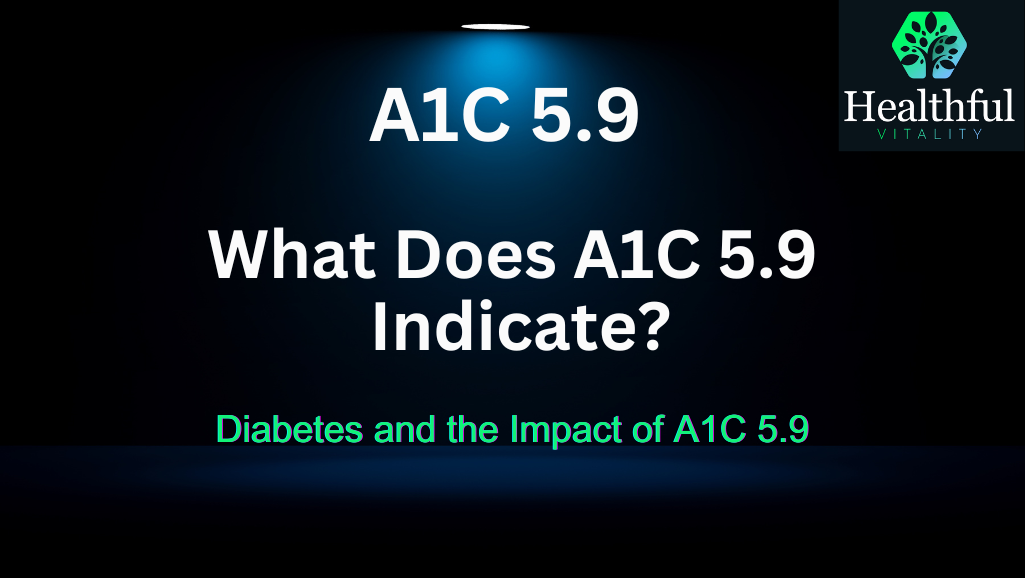What Does A1C 5.9 Indicate?
Healthful Vitality | Edited: 1/8/2025 | 11/2/2021 | What Does A1C 5.9 Indicate?

The two most commonly used tests for testing diabetes or monitoring its progress are fasting blood glucose and HBA1C (or just A1C) tests. Among these tests, A1C is more reliable in many instances. The full name of A1C is the glycated hemoglobin test.
Curious about what an A1C of 5.9 means? Watch the short video below to understand its significance and what it indicates about your health.
What does this test indicate?
In the human body, red blood cells carry oxygen to organs with the help of hemoglobin. These cells derive their energy from blood glucose. However, unlike most other cells, glucose enters red blood cells passively. It means the greater the amount of glucose in the blood, the higher it accumulates in the red blood cells, making hemoglobulin glycated.
This particular test measures the level of glucose in these red blood cells instead of measuring it in plasma (the liquid part of the blood without blood cells). This generally provides much better and accurate results.
A1C and Estimated Average Glucose (eAG) Visual Chart
| A1C (%) | eAG (mg/dL) |
|---|---|
| 5.0 | 97 |
| 5.9 | 123 |
| 6.5 | 140 |
| 7.0 | 154 |
| 8.0 | 183 |
Why is this test more reliable?
The most commonly used method, which is fasting blood glucose level, measures blood levels in non-cellular parts of the blood, that is, plasma. However, plasma glucose levels may vary significantly. For example, an evening before the blood test, a person may intentionally eat a light meal leading to better test results.
On the other hand, heavy evening meals and giving the test in less than eight hours after dinner may show higher blood glucose levels. Thus, plasma blood glucose is readily affected by many factors, causing inconsistent findings.
On the contrary, A1C shows that average glucose accumulated in the red blood cells for the last 2-3 months or more. It is because the average life of red blood cells is 90-120 days in adults.
Comparison of A1C and Fasting Blood Glucose Tests
| Feature | A1C Test | Fasting Blood Glucose |
|---|---|---|
| Timeframe Measured | 2–3 months | Point-in-time |
| Affected by Recent Meals? | No | Yes |
| Reliability | High | Variable |
| Purpose | Diagnosis & Monitoring | Primarily Diagnosis |
It means that the A1C test is less affected by the meals before the test or other factors. Thus, this test is especially more reliable for monitoring the progress of the disease. It is also highly beneficial for tracking the effectiveness of the treatment.
What does a value of A1C 5.9 mean?
This test may be used to diagnose diabetes, but it is better for monitoring the disease progress. It is also better for tracking the effectiveness of lifestyle intervention. After all, it shows the average of last two to three months.
For a person not living with diabetes, 4% to 5.6% A1C is a normal range. Values between 5.7% and 6.4% indicate prediabetes, and any value above 6.5% confirms diabetes. Thus, for a person not diagnosed with diabetes earlier, an A1C of 5.9 may indicate prediabetes.
Table: A1C Ranges and Their Interpretations
| A1C Range | Interpretation |
|---|---|
| 4.0% – 5.6% | Normal |
| 5.7% – 6.4% | Prediabetes |
| 6.5% or higher | Diabetes Diagnosis |
However, these results would be interpreted quite differently for those living with diabetes. For most people with diabetes, the target of the therapy is to achieve an A1C of 6.5% or lower. Thus, A1C of 5.9 may indicate excellent results. In addition, it shows that the therapy or lifestyle interventions are highly successful in an individual. It is vital to know that those living with diabetes should always agree on the A1C target with the treating doctor. For most young adults with diabetes, the recommended target is 6.5%. However, for older adults, even a higher target of A1C 7% is quite acceptable.
Summary and Takeaway: What Does a Value of A1C 5.9 Mean?
The A1C test, also known as the glycated hemoglobin test, is a critical tool for assessing long-term blood sugar control. Unlike fasting blood glucose tests, which are influenced by recent meals and fasting periods, the A1C test provides a reliable measure of the average blood glucose levels over the past 2–3 months by analyzing glucose bound to hemoglobin in red blood cells.
For individuals without diabetes, an A1C value between 4% and 5.6% is normal, while values between 5.7% and 6.4% indicate prediabetes, a key warning sign to adopt preventive measures. In people living with diabetes, an A1C of 6.5% or lower is typically the target, with 5.9% reflecting excellent management of the condition.
Takeaway:
The A1C test is a powerful indicator for diagnosing diabetes, monitoring its progression, and evaluating the effectiveness of treatments or lifestyle interventions. According to the American Diabetes Association, individuals with prediabetes who lower their A1C by just 0.3% can reduce their risk of developing diabetes by up to 25%.
Whether you’re aiming to prevent diabetes or maintain optimal glucose control, understanding your A1C level is essential. Always consult your doctor to set personalized health goals based on your unique needs.
Also Read: How Does Diabetes Affect a Woman Sexually?
